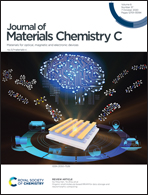Dielectric properties and reliability enhancement of atomic layer deposited thin films by in situ atomic layer substrate biasing†
Abstract
A novel “atomic layer substrate biasing (ALSB)” technique is proposed to improve the dielectric properties including film density, dielectric constant (K), and leakage current density (Jg) and the reliability of nanoscale thin films. In the ALSB process, in situ Ar plasma generated by substrate biasing is layer-by-layer introduced into each cycle of atomic layer deposition. Energy delivery from the plasma toward the as-deposited layer boosts the migration of adatoms, leading to ∼10% increase of the film density, ∼3-order-of-magnitude reduction of Jg, and an increment of K being as large as 40.7 of a ZrO2 layer of ∼5 nm. The reliability enhancement upon the ALSB treatment is demonstrated by constant-voltage-stress (CVS) and the time-dependent-dielectric-breakdown (TDDB) tests, which confirm the suppression of stress-induced traps and a high electric field of 4.7 MV cm−1 projected for a 10 year lifetime. Significant improvements in the film density, Jg, K, and the reliability indicate that ALSB is a highly effective technique to modify the quality of ALD-deposited thin films, which can be widely used in a variety of fields including energy saving, green energy, nanoelectronics, and biomedical applications.



 Please wait while we load your content...
Please wait while we load your content...